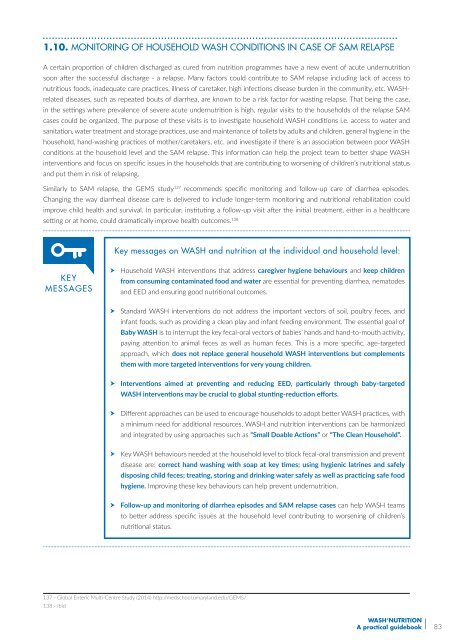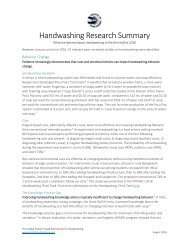WASH’ Nutrition
manuel_wash_nutrition_online
manuel_wash_nutrition_online
Create successful ePaper yourself
Turn your PDF publications into a flip-book with our unique Google optimized e-Paper software.
1.10. monitoring of HOUSEHOLD WASH CONDITIONS IN CASE OF SAM relapse<br />
A certain proportion of children discharged as cured from nutrition programmes have a new event of acute undernutrition<br />
soon after the successful discharge - a relapse. Many factors could contribute to SAM relapse including lack of access to<br />
nutritious foods, inadequate care practices, illness of caretaker, high infections disease burden in the community, etc. WASHrelated<br />
diseases, such as repeated bouts of diarrhea, are known to be a risk factor for wasting relapse. That being the case,<br />
in the settings where prevalence of severe acute undernutrition is high, regular visits to the households of the relapse SAM<br />
cases could be organized. The purpose of these visits is to investigate household WASH conditions i.e. access to water and<br />
sanitation, water treatment and storage practices, use and maintenance of toilets by adults and children, general hygiene in the<br />
household, hand-washing practices of mother/caretakers, etc. and investigate if there is an association between poor WASH<br />
conditions at the household level and the SAM relapse. This information can help the project team to better shape WASH<br />
interventions and focus on specific issues in the households that are contributing to worsening of children’s nutritional status<br />
and put them in risk of relapsing.<br />
Similarly to SAM relapse, the GEMS study 137 recommends specific monitoring and follow-up care of diarrhea episodes.<br />
Changing the way diarrheal disease care is delivered to include longer-term monitoring and nutritional rehabilitation could<br />
improve child health and survival. In particular, instituting a follow-up visit after the initial treatment, either in a healthcare<br />
setting or at home, could dramatically improve health outcomes. 138<br />
Key messages on WASH and nutrition at the individual and household level:<br />
KEY<br />
MESSAGES<br />
Household WASH interventions that address caregiver hygiene behaviours and keep children<br />
from consuming contaminated food and water are essential for preventing diarrhea, nematodes<br />
and EED and ensuring good nutritional outcomes.<br />
Standard WASH interventions do not address the important vectors of soil, poultry feces, and<br />
infant foods, such as providing a clean play and infant feeding environment. The essential goal of<br />
Baby WASH is to interrupt the key fecal-oral vectors of babies’ hands and hand-to-mouth activity,<br />
paying attention to animal feces as well as human feces. This is a more specific, age-targeted<br />
approach, which does not replace general household WASH interventions but complements<br />
them with more targeted interventions for very young children.<br />
Interventions aimed at preventing and reducing EED, particularly through baby-targeted<br />
WASH interventions may be crucial to global stunting-reduction efforts.<br />
Different approaches can be used to encourage households to adopt better WASH practices, with<br />
a minimum need for additional resources. WASH and nutrition interventions can be harmonized<br />
and integrated by using approaches such as “Small Doable Actions” or “The Clean Household”.<br />
Key WASH behaviours needed at the household level to block fecal-oral transmission and prevent<br />
disease are: correct hand washing with soap at key times; using hygienic latrines and safely<br />
disposing child feces; treating, storing and drinking water safely as well as practicing safe food<br />
hygiene. Improving these key behaviours can help prevent undernutrition.<br />
Follow-up and monitoring of diarrhea episodes and SAM relapse cases can help WASH teams<br />
to better address specific issues at the household level contributing to worsening of children’s<br />
nutritional status.<br />
137 - Global Enteric Multi-Centre Study (2014) http://medschool.umaryland.edu/GEMS/<br />
138 - Ibid<br />
<strong>WASH’</strong><strong>Nutrition</strong><br />
A practical guidebook<br />
83



